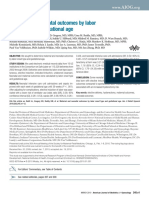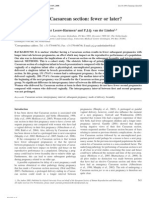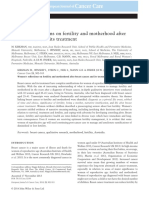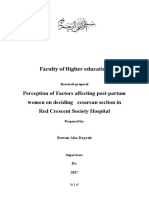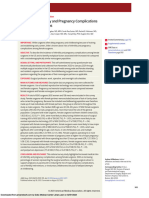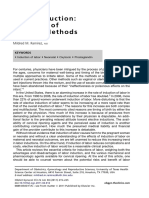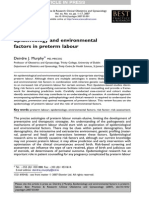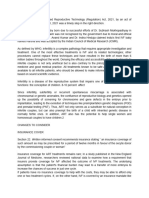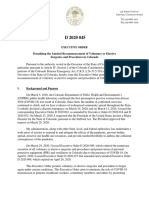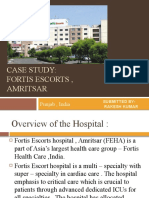Desa Research Proposal Idea Paper
Desa Research Proposal Idea Paper
Uploaded by
api-302310876Copyright:
Available Formats
Desa Research Proposal Idea Paper
Desa Research Proposal Idea Paper
Uploaded by
api-302310876Original Title
Copyright
Available Formats
Share this document
Did you find this document useful?
Is this content inappropriate?
Copyright:
Available Formats
Desa Research Proposal Idea Paper
Desa Research Proposal Idea Paper
Uploaded by
api-302310876Copyright:
Available Formats
Running head: DECREASING PRIMARY CESAREANS
Nursings Contribution to Decreasing Primary Cesarean Rates:
Research Proposal Idea Paper
Katherine deS
SUNY Institute of Technology
DECREASING PRIMARY CESAREANS
Nursings Contribution to Decreasing Primary Cesarean Rates:
Research Proposal Idea Paper
Background
The primary cesarean section rate for obstetrical delivery, along with its associated
complications and expense, has been on the rise at an astronomical rate (Caughey, 2009). Citing
MacDorman, Menacker, & Declercq (2008), Caughey (2009) states although we have seen the
cesarean rate rise 50% since 1995, there has been no concomitant reduction in neonatal
morbidity and mortality (p. 717). More and more women are choosing, or steered, toward
primary cesareans for delivery for a myriad of reasons, but newborns are not ending up healthier
for it. In fact, as the rate of cesarean deliveries increases, so does the rate of maternal mortality
(Caughey, 2009). In the US healthcare culture, free will and medical technology are highly
valued, leading to increased numbers of c-sections on demand (Alnaif & Beydon, 2012) as well
as paternalistic practices on the part of healthcare providers (Deline et al., 2012). When
combined with the highly litigious environment that medicine is practiced in, it has been difficult
to reverse this trend because attempts to deter c-sections are often viewed as an attack on
personal choice or the primacy of the doctor/patient relationship (Deline et al., 2012). However,
when nurses act as patient advocates, positive patient outcomes can be seen (Lyndon et al.,
2011).
Problem statement
The increasing rate of cesarean sections, coupled with the declining rate of attempted
vaginal births after cesarean (VBAC), is leading to higher rates of complications for mothers
(Caughey, 2009), inflated costs for healthcare (DSouza & Arulkumaran, 2013), and delayed
breastfeeding (Zanardo et al., 2010) without any measurable decrease in infant morbidity and
mortality (Caughey, 2009).
DECREASING PRIMARY CESAREANS
Purpose of the Research
In order to decrease the rate of primary cesareans, we need to address the problem from a
number of angles. For this research, the impact that nursing can have on the cesarean rate is
explored. Lyndon et al. (2011) established that nurses can affect positive change in patient
outcomes by acting as vocal patient advocates. Berard (2008) and Goldberg (2009) discuss how
educating patients can lead to more informed choices. The purpose of this research is to answer
the question, What self-described personality characteristics, if any, of labor & delivery nurses
lead to lower rates of primary non-scheduled cesarean sections? I specify non-scheduled at this
time because nurses have very little opportunity to effect change on patients who come to the
hospital on the day of a scheduled surgery.
Applicable Theories
Gadows Existential Advocacy
This theory espouses the idea that the freedom of self-determination is a primary
fundamental right (Bishop & Scudder, 2003). It is, therefore, the distinct role of nurses to
advocate for those choices the patient would make for herself (Bishop & Scudder, 2003).
Existential advocacy focuses on treating the body objectively without reducing the patient to an
object (Bishop & Scudder, 2003, p. 108). For my research, nurses personality characteristics
that encourage patient advocacy might have some bearing on the cesarean rate. Bu & Wu (2008)
designed a tool for measuring nurses likelihood for engaging in patient advocacy activities
which could be useful for my research.
Game Theory
According to Tarrant, Dixon-Woods, Colman, & Stokes (2010), game theory suggests
that social norms, awareness of others reputations, and signals of trustworthiness from verbal
and nonverbal communication influence decisions about trust and cooperation, alongside the
structural and dynamic aspects of the situations within which individuals interact (p. 441). I am
DECREASING PRIMARY CESAREANS
exploring how this theory could relate to my question on a number of levels, particularly in
patient interpretations of nonverbal cues of trustworthiness both from the nurse and the
obstetrician. I would hypothesize that maternity nurses who give verbal and nonverbal cues of
trustworthiness would be able to elicit more cooperation with techniques and interventions
designed to reduce the odds of cesarean rate, such as anesthesia free delivery and mobility during
labor.
Orems Self Care Deficit Theory
In Orems theory, patients seek nursing care when they have a need that they are
incapable of addressing on their own and require teaching and guidance to do so (Orem, 2001).
Orem (1991) believes that within the theory of self-care, person and environment are identified
as a unity characterized by human-environmental interchanges and by the impact of one on the
other (p. 143). It is nursings responsibility to teach patients coping skills in order to fill the
self-care void (Orem, 2001). Orems theory is applicable to my research study because it forms
part of the basis for my hypothesis that nurses who educate, advocate, and coach women
adequately through childbirth can remove the fear and stress responses that contribute to
increased cesarean deliveries.
Conclusion
The steady increase in cesarean sections for obstetrical delivery is leading to undue
increases in healthcare costs and rising complication rates for mothers with little to no benefit for
newborns. To address this problem, it needs to be combatted from multiple angles. Due to the
intimate, personal relationship between the labor & delivery nurse and the mother, the nurse may
have an impact on her ultimate mode of delivery. This research study, therefore, would address
the following research question: What characteristics, if any, of labor & delivery nurses lead to
lower rates of primary non-scheduled cesarean sections? Utilizing existential advocacy, self-care
deficit, and game theory to form a hypothesis, I would predict that nurses who highly identified
DECREASING PRIMARY CESAREANS
themselves as trustworthy and outspoken would have a lower primary cesarean rate than those
who identified themselves and inexperienced, softspoken, or patriarchal.
DECREASING PRIMARY CESAREANS
References
Alnaif, B. & Beydon, H. (2012). Practice of primary elective cesarean upon maternal request in
the commonwealth of Virginia. JOGNN: Journal of Obstetric, Gynecologic & Neonatal
Nursing, 41(6), 738-746. doi: 10.1111/j.1552-6909.2012.01387.x
Berard, V. (2008). Restoring balance in maternity care... "Combating coercion: breech birth,
parturient choice, and the evolution of evidence-based maternity care" (Birth
2007;34(2):176-180). Birth: Issues In Perinatal Care, 35(1), 86-87.
Bishop, A., & Scudder, J. R. (2003). Gadow's contribution to our philosophical interpretation of
nursing. Nursing Philosophy, 4(2), 104-110. doi: 10.1046/j.1466-769X.2003.00125.x
Bu, X., & Wu, Y. (2008). Development and psychometric evaluation of the instrument: attitude
toward patient advocacy. Research in Nursing & Health, 31(1), 63-75. doi:
10.1002/nur.20233
Caughey, A. (2009). Reducing primary cesarean delivery: can we prevent current and future
morbidity and mortality? Journal of Perinatology, 29(11), 717-718.
doi: 10.1038/jp.2009.132
Deline, J., Varnes-Epstein, L., Dresang, L.T., Gideonsen, M., Lynch, L., & Frey, J.F. (2012).
Low primary cesarean rate and high VBAC rate with good outcomes in an Amish
birthing center. Annals of Family Medicine, 10(6), 530-537. doi:10.1370/afm.1403
D'souza, R., & Arulkumaran, S. (2013). To 'C' or not to 'C'?/Caesarean delivery upon maternal
request: a review of facts, figures and guidelines. Journal Of Perinatal Medicine, 41(1),
5-15. doi: 10.1515/jpm-2012-0049
Goldberg, H. (2009). Informed decision making in maternity care. Journal of Perinatal
Education, 18(1), 32-40.
Gould, D. (2008). Professional dominance and subversion in maternity services. British Journal
of Midwifery, 16(4), 210.
DECREASING PRIMARY CESAREANS
Lothian, J. (2009). Ethics and maternity care: from principles to practice. Journal of Perinatal
Education, 18(1), 1-3.
Lyndon, A., Sexton, J., Simpson, K., Rosenstein, A. H., Lee, K., & Wachter, R. M. (2011).
Predicting likelihood of speaking up in labor & delivery. JOGNN: Journal of Obstetric,
Gynecologic & Neonatal Nursing, 40(S), 117-8. doi: 10.1111/j.1552-6909.2011.01243
MacDorman, M., Menacker, F., & Declercq, E. (2008). Cesarean birth in the United States:
epidemiology, trends, and outcomes. Clinical Perinatology, 35(2): 293307.
doi: 10.1016/j.clp.2008.03.007
Orem, D. E. (1991). Nursing: Concepts of Practice (4th ed.). St Louis: Mosby.
Orem, D. E. (2001). Nursing: Concepts of practice (6th ed.). St. Louis: Mosby.
Schmidt, N. (2008). Guided imagery as internally oriented self-care: a nursing case. Self-Care,
Dependent-Care & Nursing, 16(1), 41-48.
Tarrant, C., Dixon-Woods, M., Colman, A., & Stokes, T. (2010). Continuity and trust in primary
care: a qualitative study informed by game theory. Annals of Family Medicine, 8(5), 440446. doi: 10.1370/afm.1160
Walker, H. (2008). The balance of power. Nursing Standard, 22(27), 64.
Wood, M.J. & RossKerr, J.C. (2011). Basic steps in planning nursing research: From question
to proposal (7th ed.). Sudbury, MA: Jones & Bartlett. ISBN: 9780763771799
Zanardo, V., Svegliado, G., Cavallin, F., Giustardi, A., Cosmi, E., Litta, P., & Trevisanuto, D.
(2010). Elective cesarean delivery: does it have a negative effect on breastfeeding? Birth:
Issues In Perinatal Care, 37(4), 275-279. doi: 10.1111/j.1523-536X.2010.00421.x
You might also like
- Pico PaperDocument7 pagesPico Paperapi-23766825450% (2)
- FactorsthatinfluencemotherstobreastfeedDocument18 pagesFactorsthatinfluencemotherstobreastfeedapi-353823437No ratings yet
- Letter For Employment PromotionDocument5 pagesLetter For Employment PromotionSample BakeshopNo ratings yet
- Martin and FanaroffDocument5 pagesMartin and FanaroffAnonymous FfZm5kOkYF0% (1)
- Midwifery Care at A Freestanding Birth Center: A Safe and Effective Alternative To Conventional Maternity CareDocument20 pagesMidwifery Care at A Freestanding Birth Center: A Safe and Effective Alternative To Conventional Maternity CareYulinda AswanNo ratings yet
- Pi Is 0002937810000815 JournallDocument12 pagesPi Is 0002937810000815 JournallRaisa AriesthaNo ratings yet
- ComparisonofcnmvsmdcareDocument9 pagesComparisonofcnmvsmdcarePandora HardtmanNo ratings yet
- Lit Review NealeDocument9 pagesLit Review Nealeapi-726948535No ratings yet
- Home BirthDocument33 pagesHome BirthMarlon Royo100% (2)
- Patient Education To Reduce Elective Labor InductionsDocument7 pagesPatient Education To Reduce Elective Labor InductionsNoraNo ratings yet
- Research Priorities in Obstetrics SeminarDocument7 pagesResearch Priorities in Obstetrics SeminarSharmistha Debnath86% (7)
- DP 203Document63 pagesDP 203charu parasherNo ratings yet
- Forster 2016Document13 pagesForster 2016INA SAKTINo ratings yet
- Optimal Birth Spacing: What Can We Measure and What Do We Want To Know?Document3 pagesOptimal Birth Spacing: What Can We Measure and What Do We Want To Know?rizmahNo ratings yet
- Examples of Breastfeeding DissertationDocument5 pagesExamples of Breastfeeding DissertationWriteMyPaperForMeIn3HoursCanada100% (1)
- Literature Review About Evidence Based Practice in MidwiferyDocument7 pagesLiterature Review About Evidence Based Practice in MidwiferydhjiiorifNo ratings yet
- Accepted ManuscriptDocument27 pagesAccepted ManuscriptsilvanaNo ratings yet
- Pregnancy After Caesarean Section: Fewer or Later?: J.J.H. Eijsink, L. Van Der Leeuw-Harmsen and P.J.Q. Van Der LindenDocument5 pagesPregnancy After Caesarean Section: Fewer or Later?: J.J.H. Eijsink, L. Van Der Leeuw-Harmsen and P.J.Q. Van Der LindenSamuel Albert Andrian SiagianNo ratings yet
- Reflective JournalsDocument19 pagesReflective JournalsisisvlvtNo ratings yet
- To Ignore or Not To Ignore Placental Calcifications On Prenatal Ultrasound: A Systematic Review and Meta-AnalysisDocument22 pagesTo Ignore or Not To Ignore Placental Calcifications On Prenatal Ultrasound: A Systematic Review and Meta-AnalysisMaulida HalimahNo ratings yet
- Social Science & Medicine: Anna L. Altshuler, Alison Ojanen-Goldsmith, Paul D. Blumenthal, Lori R. FreedmanDocument8 pagesSocial Science & Medicine: Anna L. Altshuler, Alison Ojanen-Goldsmith, Paul D. Blumenthal, Lori R. FreedmanCristina ToaderNo ratings yet
- Ni Hms 916466Document20 pagesNi Hms 916466cataghyNo ratings yet
- McDonald Et Al-2015-BJOG - An International Journal of Obstetrics & GynaecologyDocument8 pagesMcDonald Et Al-2015-BJOG - An International Journal of Obstetrics & GynaecologyKevin LoboNo ratings yet
- Rev NovemberDocument11 pagesRev NovemberLloyd VenturaNo ratings yet
- The Complementary Therapies For Labour and Birth StudyDocument31 pagesThe Complementary Therapies For Labour and Birth StudylilahgreenyNo ratings yet
- Nursing Research PaperDocument17 pagesNursing Research PaperZacob Anthony100% (1)
- Nihms 409687Document22 pagesNihms 409687ngocphuc190197No ratings yet
- Okolie Stephaine 1-3Document11 pagesOkolie Stephaine 1-3Confidence BlessingNo ratings yet
- Literature Review On StillbirthDocument6 pagesLiterature Review On Stillbirthaflsvagfb100% (1)
- Midwifery Dissertation QuestionsDocument5 pagesMidwifery Dissertation QuestionsWritingPaperServicesReno100% (1)
- F8 Reading-Birth To Death Symposium-Home BirthDocument5 pagesF8 Reading-Birth To Death Symposium-Home Birthemkay1234No ratings yet
- Effects of Prenatal Care Wolanzyk Guterwill Watkins Evans Masone 3Document15 pagesEffects of Prenatal Care Wolanzyk Guterwill Watkins Evans Masone 3api-454127095No ratings yet
- Ebp Final PaperDocument40 pagesEbp Final Paperapi-557314921No ratings yet
- Kirkman Et Al. - Fertility and Motherhood After Breast Cancer... (2014) PDFDocument12 pagesKirkman Et Al. - Fertility and Motherhood After Breast Cancer... (2014) PDFCSNo ratings yet
- An Exploratory Metasynthesis of Midwifery Practice in The United StatesDocument13 pagesAn Exploratory Metasynthesis of Midwifery Practice in The United Statesintan megaNo ratings yet
- Effects of Prenatal Care Wolanzyk Guterwill Watkins Evans MasoneDocument15 pagesEffects of Prenatal Care Wolanzyk Guterwill Watkins Evans Masoneapi-455796674No ratings yet
- Hunt-Gibbon SUM 2019Document34 pagesHunt-Gibbon SUM 2019fatimaNo ratings yet
- Sekdes BantayanDocument15 pagesSekdes BantayanMuhammad rizalNo ratings yet
- Faculty of Higher Education: Rawan Abu DayyahDocument31 pagesFaculty of Higher Education: Rawan Abu DayyahMALIK MANASRAHNo ratings yet
- Butler 2015Document8 pagesButler 2015Lydia AmaliaNo ratings yet
- Ethics - Nursing Shortage IssueDocument7 pagesEthics - Nursing Shortage Issueapi-355702962No ratings yet
- Antenatal Care As A Means of Increasing Birth in The Health Facility and Reducing Maternal Mortality: A Systematic ReviewDocument12 pagesAntenatal Care As A Means of Increasing Birth in The Health Facility and Reducing Maternal Mortality: A Systematic ReviewAHISSOU Crédo AdelpheNo ratings yet
- Pregnancy With Gestational Hypertension or Preeclampsia A Qualitative Exploration of Women S Experiences - 2017 - Midwifery PDFDocument7 pagesPregnancy With Gestational Hypertension or Preeclampsia A Qualitative Exploration of Women S Experiences - 2017 - Midwifery PDFfujimeisterNo ratings yet
- Infertility SurgeonsDocument11 pagesInfertility SurgeonsfswhxrzkckNo ratings yet
- Literature Review On Birth PreparednessDocument5 pagesLiterature Review On Birth Preparednessmgrekccnd100% (1)
- Midwifery: Contents Lists Available atDocument9 pagesMidwifery: Contents Lists Available atVicky Prasetya NugrahaNo ratings yet
- Finalproject-Analysis and Utilization of ResearchDocument11 pagesFinalproject-Analysis and Utilization of Researchapi-320739622No ratings yet
- Laborinduction: Areviewof Currentmethods: Mildred M. RamirezDocument11 pagesLaborinduction: Areviewof Currentmethods: Mildred M. RamirezRolando DiazNo ratings yet
- Preterm Birth ReviewDocument17 pagesPreterm Birth ReviewfahlevyNo ratings yet
- Factors Influencing Contraceptive Uptake Among Lactating Mothers (6-24 Months) - A Case Study of 2medical Reception Station (2MRS)Document7 pagesFactors Influencing Contraceptive Uptake Among Lactating Mothers (6-24 Months) - A Case Study of 2medical Reception Station (2MRS)NanaKarikariMintahNo ratings yet
- Safety of HomebirthDocument7 pagesSafety of Homebirthhollieshannon344No ratings yet
- Clinical Question PaperDocument10 pagesClinical Question Paperapi-264944678No ratings yet
- Effects of Prenatal Care Wolanzyk Guterwill Watkins Evans Masone 2Document15 pagesEffects of Prenatal Care Wolanzyk Guterwill Watkins Evans Masone 2api-453119244No ratings yet
- Final Research PaperDocument22 pagesFinal Research Paperapi-351971578No ratings yet
- Research Paper On Pregnancy and ChildbirthDocument8 pagesResearch Paper On Pregnancy and Childbirthnywxluvkg100% (1)
- A Suggested Approach For Implementing CONSORT Guidelines Specific To Obstetric ResearchDocument5 pagesA Suggested Approach For Implementing CONSORT Guidelines Specific To Obstetric ResearchminhhaiNo ratings yet
- What Are The Challenges Related To Family Planning, Pregnancy, and Parenthood Faced by Women in Orthopaedic Surgery A Systematic ReviewDocument12 pagesWhat Are The Challenges Related To Family Planning, Pregnancy, and Parenthood Faced by Women in Orthopaedic Surgery A Systematic ReviewFrancisco GonzalezNo ratings yet
- Running Head: Integrative Literature Review 1Document21 pagesRunning Head: Integrative Literature Review 1api-483044745No ratings yet
- Generational Differences in Nurses' Characteristics, Job Satisfaction, Quality of Work Life, and Psychological EmpowermentDocument11 pagesGenerational Differences in Nurses' Characteristics, Job Satisfaction, Quality of Work Life, and Psychological EmpowermentPurnama YunusNo ratings yet
- IVF-RYPDocument8 pagesIVF-RYPkhushikhannaasr1701No ratings yet
- Preconception Health and Care: A Life Course ApproachFrom EverandPreconception Health and Care: A Life Course ApproachJill ShaweNo ratings yet
- Reducing Racial/Ethnic Disparities in Reproductive and Perinatal Outcomes: The Evidence from Population-Based InterventionsFrom EverandReducing Racial/Ethnic Disparities in Reproductive and Perinatal Outcomes: The Evidence from Population-Based InterventionsArden HandlerNo ratings yet
- Sleep Deprivation PowerpointDocument24 pagesSleep Deprivation Powerpointapi-302310876100% (1)
- Desa Katherine Resume CVDocument2 pagesDesa Katherine Resume CVapi-302310876No ratings yet
- Desa Emtala PowerpointDocument20 pagesDesa Emtala Powerpointapi-302310876No ratings yet
- Preceptor Training Course OutlineDocument4 pagesPreceptor Training Course Outlineapi-302310876100% (1)
- NSG 463 Crystal R Hollemon RN ResumeDocument2 pagesNSG 463 Crystal R Hollemon RN Resumeapi-577895547No ratings yet
- Innovation in Nursing Leadership: A Skill That Can Be LearnedDocument7 pagesInnovation in Nursing Leadership: A Skill That Can Be LearnedRay HannaNo ratings yet
- Veterinary Technology Program Handbook: 2019 Laguardia Community CollegeDocument24 pagesVeterinary Technology Program Handbook: 2019 Laguardia Community CollegeSandri Alexandra NegreanuNo ratings yet
- Good Occlusal Practice in The Provision of Implant Borne ProsthesesDocument10 pagesGood Occlusal Practice in The Provision of Implant Borne ProsthesesNoland NaidooNo ratings yet
- Time Lost Is Brain Lost.: Target: Stroke Campaign ManualDocument9 pagesTime Lost Is Brain Lost.: Target: Stroke Campaign ManualOcha24 TupamahuNo ratings yet
- Drug Study - CetirizineDocument3 pagesDrug Study - Cetirizinekkd nyleNo ratings yet
- Lifemark ON MVA Billing AgreementDocument1 pageLifemark ON MVA Billing AgreementRavi KaushikNo ratings yet
- Guidelines For The Conduct of Clinical Trials in Uganda PDFDocument61 pagesGuidelines For The Conduct of Clinical Trials in Uganda PDFTumusiime Nelson Banturaki100% (1)
- Colorado Elective Surgeries Order April 26, 2020Document5 pagesColorado Elective Surgeries Order April 26, 2020Michael_Roberts2019No ratings yet
- Funda 1Document7 pagesFunda 1Kat Taasin100% (1)
- m1 MonthlyDocument54 pagesm1 Monthlymaroseg21No ratings yet
- 6080 Devices Opportunities and Challenges of Swiss CompaniesDocument138 pages6080 Devices Opportunities and Challenges of Swiss CompaniesmaneeshkapoorNo ratings yet
- European J of Heart Fail - 2021 - Greene - Another Reason To Embrace Quadruple Medical Therapy For Heart FailureDocument4 pagesEuropean J of Heart Fail - 2021 - Greene - Another Reason To Embrace Quadruple Medical Therapy For Heart FailureSrinivas PingaliNo ratings yet
- Allotlist p2Document182 pagesAllotlist p2Salman SAYYADNo ratings yet
- Case Study: Fortis Escorts, Amritsar: Punjab, IndiaDocument37 pagesCase Study: Fortis Escorts, Amritsar: Punjab, IndiaShreya Garg100% (1)
- Afework Business PalnDocument31 pagesAfework Business PalnAbel GetachewNo ratings yet
- AdultDehydrationGuidelineJuly2015 PDFDocument3 pagesAdultDehydrationGuidelineJuly2015 PDFmarselamgeNo ratings yet
- AO2021-0066 Guidelines On The Issuance of Certificate On Inclusion (COI) in The Blood Services Network (BSN)Document17 pagesAO2021-0066 Guidelines On The Issuance of Certificate On Inclusion (COI) in The Blood Services Network (BSN)gravadorceciliaNo ratings yet
- Perioperative NursingDocument8 pagesPerioperative NursinglovethestarNo ratings yet
- MS Preoperative Part 2Document5 pagesMS Preoperative Part 2Ano NymousNo ratings yet
- Forensic Science TechnicianDocument12 pagesForensic Science Technicianapi-299927057No ratings yet
- Quick Facts BrochureDocument6 pagesQuick Facts Brochurenifej15595No ratings yet
- Name Tag ATLS 21-23 Juni 2019 No 38-67Document15 pagesName Tag ATLS 21-23 Juni 2019 No 38-67Gun Gun GunawanNo ratings yet
- Full SC Training SlidesDocument151 pagesFull SC Training Slidesapi-737922285No ratings yet
- TQM in Corporate Hospitals - Using Six SigmaDocument15 pagesTQM in Corporate Hospitals - Using Six SigmaApollo Institute of Hospital Administration100% (3)
- PPTDocument30 pagesPPTSr. Nichelle of Crucified JesusNo ratings yet
- Accepted Manuscript: International Journal of Nursing SciencesDocument28 pagesAccepted Manuscript: International Journal of Nursing SciencesEko PrasetyoNo ratings yet
- Diverse Product Basket: Therapeutic CategoryDocument8 pagesDiverse Product Basket: Therapeutic CategoryGYANNo ratings yet





